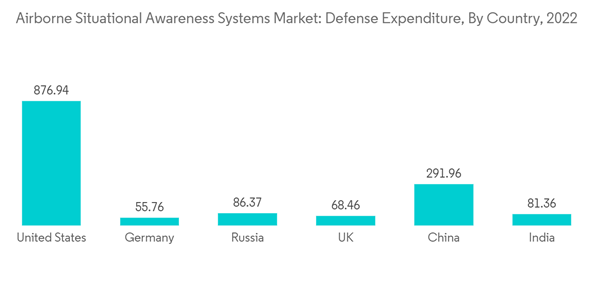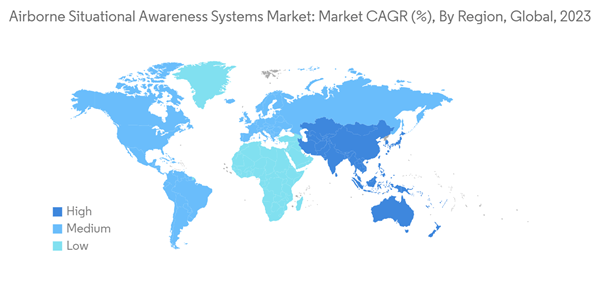The rise in terrorism, tensions between countries, illicit trade, border skirmishes, highly advanced anti-aircraft missile systems, electronic warfare, etc., are propelling governments to increase their military spending to raise the air superiority of their existing air force fleet for combat and intelligence and surveillance and reconnaissance operations. This factor is increasing the demand for airborne situational awareness systems across the world.
The increasing focus on miniaturization and improving the accuracy of the ISR systems and payloads are driving their utilization across all platforms. Their high reliability and availability at low costs have encouraged militaries to procure these systems in abundance. As a new line of threats emerges, these systems have become an integral part of military preparedness due to their utility.
Rapid technological developments are breeding disruptive technologies in the defense industry. The current focus is on incorporating technologies such as AI and machine learning into the airborne situational awareness systems platforms. As situational awareness is becoming critical in making decisions and acting in ISR missions, the size and volume of data and the complexity created by fusion and aggregation affect processing speeds that impair usage.
Airborne Situational Awareness Systems Market Trends
Sensor Segment is Expected to Grow with Highest CAGR During the Forecast Period
The rise in the demand for electronic warfare equipment and systems and wide surveillance and reconnaissance are aiding the growth of sensor-based radar and imaging systems. The increasing use of sophisticated MANPADS and ground-based air defense systems is elevating the risks for airborne assets. This factor drives the demand for situational awareness systems on drones, fighters, and transport aircraft. In October 2023, Shield AI, America’s AI pilot-building defense technology company, was awarded a long-term agreement (LTA) with Australia’s artificial intelligence (AI) technology company, Sentient Vision (Sentient), to deliver a new generation-wide area motion image (wami) solution. Shield AI has been granted a long-term, multi-unit supply contract with Sentient to deliver Sentient's ViDAR solution on the unmanned aerial vehicle (UAV). The first deliveries of the ViDAR solution are planned for 2024.In terms of innovation, for instance, in June 2023, BAE Systems’ Electronic Combat Systems (ECS) division launched a new export-oriented airborne digital electronic warhead (EW) defense system. Storm EW is described as modular, scaleable, fully internal, and platform-agnostic. Storm works across the entire spectrum and allows for third-party software and programmability. Its primary use is likely to be protecting the massive F-16 fleet globally, but it can also be used to protect large aircraft such as transports or tankers. Such investments in the development of advanced sensors are expected to propel the growth of the market studied during the forecast period.
Asia-Pacific to Witness Highest Growth During the Forecast Period
Airborne situational awareness is essential for any country that wishes to govern its airborne zones. Asia-Pacific is home to countries such as China, India, Australia, Japan, South Korea, etc., which are significantly increasing their expenditure on the development and procurement of naval situational awareness systems to increase their battle preparedness over the sea.The countries in Asia-Pacific, such as China, India, South Korea, Japan, etc., are increasing their military expenditure to develop and acquire new-generation military fighters with advanced electronic warfare and situational awareness capabilities. The growth in geopolitical tensions and violation of maritime and aerial borders further fuel the demand for integrating new situational awareness systems in the region. With the growing emphasis on local manufacturing, the state-owned companies are developing new aircraft integrated with advanced situational awareness systems to support their respective armed forces. For instance, in August 2023, Japan awarded Northrop Grumman Corporation a USD 1.38 billion contract for an additional five AHE (Airborne Early Warning and Control) E-2D (Advanced Hawkeye) aircraft.
Similarly, in October 2022, Bharat Electronics signed the licensing agreement for the transfer of technology (LATOT) with CASDIC, DRDO, for the transfer of technology for digital radar warning receivers (DRWR). This will provide versatile situational awareness to the fighter platform in the dense signal scenario. This system offers high sensitivity, accurate parameter measurement, and a high probability of intercepting against dense signals. The development and procurement of such advanced systems are anticipated to bolster the growth of the market studied in the region.
Airborne Situational Awareness Systems Industry Overview
The airborne situational awareness systems market is fragmented, with players such as Lockheed Martin Corporation, Leonardo SpA, RTX Corporation, BAE Systems PLC, Saab AB, Elbit Systems Ltd, etc., accounting for significant market shares. The manufacturers of airborne situational awareness solutions are heavily investing in research and development to integrate technologies such as augmented reality in display systems and aircraft computers. With the increasing number of airborne ISR system providers, the competition in this market is high. This is also opening the gates for new entrants, who are coming in with the latest technologies. Partnerships in the industry may help the technology transfer between players, thereby enabling their mutual growth. Several state-owned companies are also focusing on developing their own airborne ISR capabilities, which is expected to further intensify the competition in the market.Additional Benefits:
- The market estimate (ME) sheet in Excel format
- 3 months of analyst support
This product will be delivered within 2 business days.










